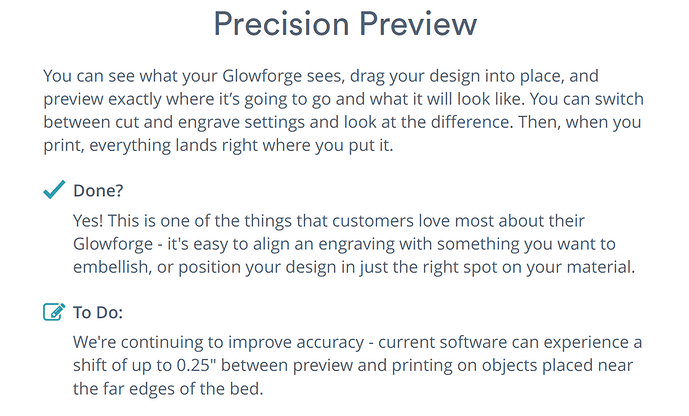I don’t disagree. It’s not elegant, but one could say “I want to place an image in “this” area. Now go use the head cam to make a couple of passes across to give me a more-detailed view of that area.”
Remember, this image isn’t what the camera is seeing. This is the result of the software de-warping what the camera is seeing.
The camera however, because it’s an ultra-wide angle lens and presumably fixed focus (since the focus ring is not motorized it is not an auto-focus) has nearly infinite depth of field.
If the camera itself is in focus, the entire optical image will be in focus, but we’re not seeing the optical image. We are seeing a software-manipulated de-warped image which can suffer artifacts.
Try placing a contrasty item dead smack in the middle of the bed directly under the lid camera. That’s the area least likely affected by the de-warping software and if it’s still considerably blurry there, then it could be an optical issue.
I was thinking about this problem the other day and wondered if it could be done with a pinhole camera without a lens. Nothing in the scene moves so it could take a long exposure. With a pin hole I think you have infinite depth of field and no distortion, other than fisheye perspective, which is just a matter of geometry.
As I recall, the diffraction distortion of a pinhole aperture is significant, and far worse than other types of distortions caused by even cheap lenses.
Yes but it is constant and only defined by geometry, so can be solved mathematically for all machines. With a lens you have additional distortions depending on its quality and that might need calibration per machine.
theoretically that could all be measured and done in software. practically most lenses are made with sufficient qa that they all end up sufficiently identical to use similar calibrations (depending of course in the manufacturer; i suppose it’s possible that they could have cheaper out). most modern cameras / lenses have all these corrections built in, for example (admittedly those lenses are probably produced to stricter qa).
I’ve never seen diffraction distortion corrected fully in software. Even modern cameras have problems with diffraction at small enough apertures. Yes, lenses have other distortions, but if the aperture is large enough, diffraction is not one of them.
Given the eye searing brightness of the LEDs I imagine they have the aperture cranked tight for DOF…
The issue with a pinhole in this particular case is we need a very wide field of view and that is the weak point of pinholes.
The closer the film plane (or sensor) is to the aperture, the wider we can push the FOV, but that creates more light fall-off at the edges of the film/sensor plane which is not ideal for this use.
We can’t add more light inside the machine in order to bring up the edges of the image, without blowing out the detail near the center of the frame. You can’t make the pinhole larger to increase the amount of light coming in, without dramatically decreasing image focus.
Yeah. I was thinking I had blur, but then I looked at the middle of the image and no, dead sharp. It’s just the corners where things get weird.
Yes the resolution will be a lot less in the corners than the middle. I.e. the camera pixels will represent a bigger area in the bed and a bigger area on the screen when it is de-warped. That will be seen as blurring, even if the original image isn’t.
Even loctite blue is likely to be stronger than the plastic it’s holding.
Loctite red is effectively permanent, as the heat required to denature it will destroy the camera.
loctite-like knockoffs may be more forgiving.
Dewarp calibration occurs at the factory for each unit separately. The variation is small but even a fraction of a millimeter is enough to change the position of the alignment on the material.
What they could do is adjust the LED brightness in the case during focus procedure to cover the full range. I believe that’s exactly what many cellphone cameras do with their flashes and you see the flash going off multiple times for a single shot… also, for HDR shots.
Cell phones do that to help their autofocus work, and it’s also red eye reduction - that flash causes subjects pupils to constrict so there is less chance of red eye in the photo, and it produces sharp contrasty shadows which helps the auto-focus lock. They snagged that trick from camera manufacturers.
HDR I’m sure you know is in fact multiple individual shots at different exposures that then get put together either manually or within software. Since it’s cloud based this might take considerably longer to process.
All that said, pinholes are extremely fussy to design and get fantastic results from. It’s much more flexible to use lensed cameras.
Aha! Of course! It never occurred to me but of course you’re right about this.
Still hate that feature though.
Why do people still see large errors when scanning a grid and engraving it over the top of itself? I would have thought de-warp calibration involved scanning a known grid and making sure the intersections were mapped to where they are known to be and everything in between interpolated. Why doesn’t that give near perfect results?
So now I wonder if I ought to expect to be able to place graphics with much accuracy at all. That doesn’t seem to be the case for me with my unit. Is that expected, or should I report it?
To be clear, the cuts and engraving are precise relative to their own features but typically when I place designs in the interface and then cut them, they’re off from where it looks as though they ought to be in the interface, and this error is different in different parts of the bed.
It hasn’t really bothered me, except that I can’t try to use material terribly close to the edge of a piece, for instance, and I’ve got zero confidence in being able to place a feature accurately on something that’s already-made, like say putting a design dead in the center of a phone case or something.
The more I describe this, the more it seems like the problem @Tom_A describes at the start of this thread.
What do you think? report?
Report it!
Be aware though that entering the exact thickness is very important to this process. This is automatic for  but you need good digital calipers for other things.
but you need good digital calipers for other things.
